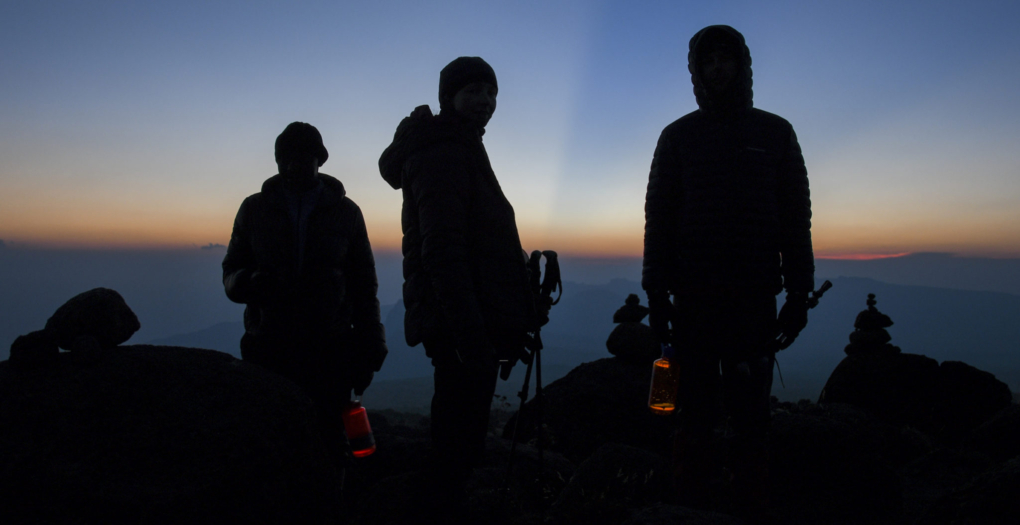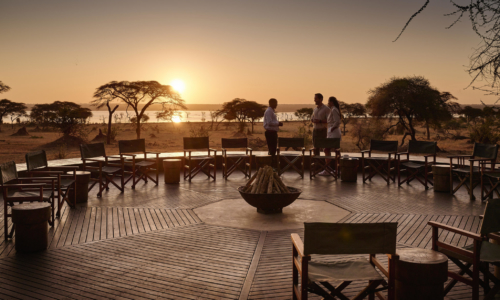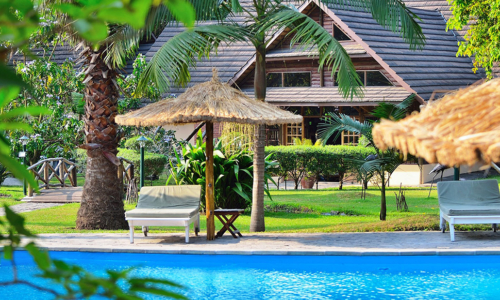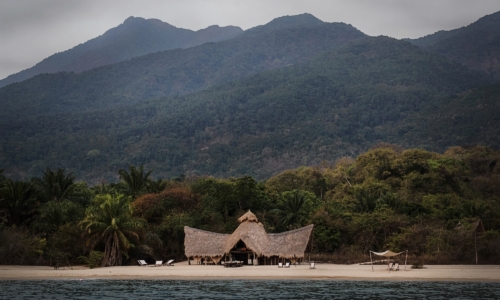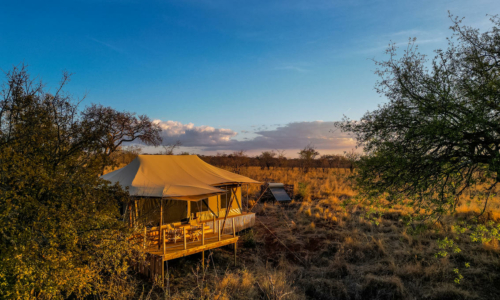One of the world’s great wonders, a snow-capped mountain sitting on the equator, Kilimanjaro is the fourth highest of the seven world summits. The mountain features three distinct volcanoes—Mawenzi and Shira, the two lower cones are extinct, and Kibo, the highest cone, lies dormant.
Kilimanjaro, known as the Roof of Africa, lies within the 291-square mile Kilimanjaro National Park, a UNESCO World Heritage site. The ascent takes hikers through several ecological zones, like walking from an equatorial desert to the North Pole in a week. “Uhuru” Peak on Kibo’s rim, Kilimanjaro’s summit, means freedom in Swahili and celebrates Tanzania’s freedom from Great Britain in 1961 … as well as the metaphoric freedom felt by those who reach the peak.
Nicknamed “Everyman’s Everest,” Mount Kilimanjaro is considered to be an easier climb than other lower but more technical mountains and requires no special climbing equipment or expertise. However, the climb should still be taken seriously as a demanding adventure, and climbing with a qualified team and key safety equipment is highly recommended. Climb pacing is vital to a successful summit, which is why spreading the ascent over as many days as possible is always recommended. The words pole pole, pronounced polay polay and meaning “slowly slowly” in Swahili, becomes the hiker’s mantra. The very shortest climb that Piper & Heath will allow for its travelers is six days/five nights, but we strongly recommend a minimum of seven days/six nights. Longer climbs allow for a slower pace, with shorter distances covered each day and more time to acclimate to the altitude.
As much as anywhere in Africa, on the mountain safety must come first. Around three months prior to departure, climbers should start a daily exercise routine at home. Once on Kilimanjaro, drinking at least three quarts of water a day is a must. The climb goes through five temperate zones, and hikers should pack accordingly. Good hiking boots are a key investment as is breaking them in well before the climb. Every climbing group will have porters that will carry all the gear.
There are four key routes up the mountain: Lemosho, Machame, Rongai, and Marangu, each with its own advantages and challenges. Breathtakingly scenic, Lemosho takes hikers through four ecological zones, beginning with lush rainforests and the chance to spot game on the lower slopes. At 42 miles, Lemosho is the longest route and the most highly recommended as it gives hikers a better chance to acclimatize. Because of the length and remoteness of the Lemosho route, those hiking it also encounter less foot traffic. It is worth the longer drive from Arusha to the Londorossi Gate.
The Machame route attracts climbers due to its impressive views and shorter distance. However, it has also been nicknamed the Whiskey Route as it is a tough climb with steeper trails and longer distances. About 37 miles from gate to gate, Machame starts at the southern base of the mountain, a short drive from Arusha, and takes hikers through a wide variety of ecological zones and stunning views. It is recommended for the physically fit.
The only route to begin on the northeast side of the mountain, Rongai offers a quieter hike through pristine wilderness with the chance to see large wildlife like antelope, elephants, and buffalo. Being drier and only moderately steep are the advantages to this route. However, the flat terrain does not allow for the “climb high, sleep low” principle of the other routes, which helps acclimatize hikers to the higher altitudes.
Finally, the Marangu route is the classic path up the mountain and the most popular. Nicknamed the Coca Cola route for its more moderate hike, it is the only route where hikers can enjoy the luxury of sleeping in rustic shared huts rather than tents. Beginning in the southeast, Marangu stays on one side of the mountain, limiting the types of views, but has the best rainforest trek of all the trails. Hikers on Marangu must trade off ease of hike for crowds, and it is recommended to not rush up this faster path, but to add in an extra day to help avoid altitude sickness.

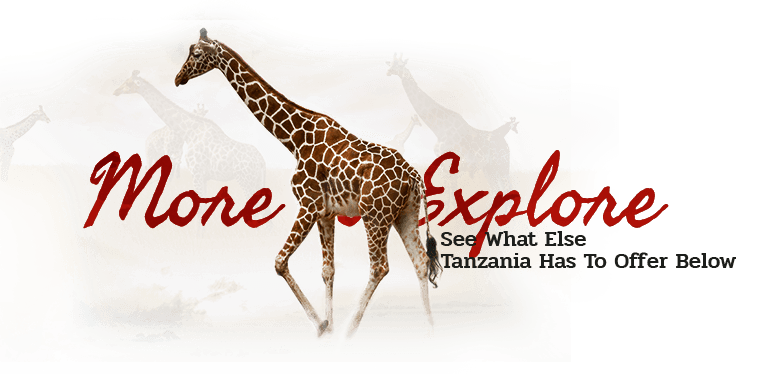
- Bashay Rift Lodge
- Beho Beho Camp
- Chada Katavi
- Chaka Camp
- Chem Chem Lodge
- Dunia Camp
- Entamanu Ngorongoro
- Entamanu Private
- Esirai Camp
- Ewanjan Tented Camp
- Faru Faru Lodge
- Forest Chem Chem
- Fumba Beach Lodge
- Fundu Lagoon
- Gibb’s Farm
- Greystoke Mahale
- Grumeti Hills
- Grumeti Serengeti River Lodge
- Ikuka Safari Camp
- Jabali Ridge
- Jongomero
- Kaskaz Mara Camp
- Kiba Point Selous
- Kichaka
- Kichakani Serengeti Camp
- Kichuguu Camp
- Kigelia Ruaha
- Kilima
- Kiota Camp
- Kisima Ngeda Camp
- Kitela Lodge
- Klein’s Camp
- Kokoko Camp
- Kuria Hills Tented Lodge
- Kuro Tarangire
- Kusini
- Kusini Kopjes Kambi
- Kwihala Camp
- Lake Manyara Tree Lodge
- Lamai Serengeti
- Little Chem Chem
- Little Oliver’s Camp
- Manyara Ranch Conservancy
- Mara River Post
- Mara River Tented Camp
- Mara Tented Camp
- Maweninga Camp
- Melia Ngorongoro
- Mila Tented Camp
- Milele
- Mkombe’s House
- Mnemba Island
- Mpingo Ridge Lodge
- Mwiba Lodge
- Namiri Plains
- Naona Moru Camp
- Nasikia Mobile Camp
- Ndutu Safari Lodge
- Ndutu Tented Camp
- Ngorongoro Crater Camp
- Ngorongoro Crater Lodge
- Ngorongoro Serena Safari Lodge
- Ngorongoro Sopa Lodge
- Ngorongoro Tented Camp
- Nomad Expeditionary Walking Camp
- Olaado Camp
- Olakira Migration Camp
- Olduvai Camp
- Olduvai Ndogo
- Oliver’s Camp
- Olkeri Camp
- Olmara Camp
- Roho ya Selous
- Ronjo Camp
- Rubondo Island Camp
- Sabora Tented Camp
- Sanctuary Serengeti Migration Camp
- Sand Rivers Selous
- Sasakwa Lodge
- Sayari Camp
- Selous Serena Camp
- Serena Mivumo River Lodge
- Serengeti Bushtops
- Serengeti House
- Serengeti Kati Kati Tented Camp
- Serengeti Migration Camp
- Serengeti Pioneer Camp
- Serengeti Safari Camp
- Serengeti Under Canvas
- Serian’s Serengeti
- Serian’s Serengeti Mobile
- Singita Explore
- Singita Kilima
- Siwandu
- Swala
- Taasa Lodge
- Tarangire Ndovu Tented Lodge
- Tarangire Safari Lodge
- Tarangire Sopa Lodge
- Tarangire Treetops
- The Highlands
- The Manor at Ngorongoro
- Ubuntu Migration Camp
- Usangu Expedition Camp
- Usawa Serengeti
- Arumeru Lodge
- Arusha Coffee Lodge
- Baraza Resort & Spa
- Breezes Beach Club & Spa
- Chole Mjini
- Dar es Salaam Serena Hotel
- Fanjove Island
- Hamerkop House
- Katambuga House
- Kilindi Zanzibar
- Lake Duluti Lodge
- Legendary Lodge
- Matemwe Beach House
- Matemwe Lodge
- Matemwe Retreat
- Ngare Sero Mountain Lodge
- Oyster Bay Hotel
- Plantation Lodge
- Rivertrees Country Inn
- The Palms
- Zanzibar Serena Hotel
- Zawadi Hotel
- Zuri Zanzibar
Coming soon!
- Bashay Rift Lodge
- Beho Beho Camp
- Chada Katavi
- Chaka Camp
- Chem Chem Lodge
- Dunia Camp
- Entamanu Ngorongoro
- Entamanu Private
- Esirai Camp
- Ewanjan Tented Camp
- Faru Faru Lodge
- Forest Chem Chem
- Fumba Beach Lodge
- Fundu Lagoon
- Gibb’s Farm
- Greystoke Mahale
- Grumeti Hills
- Grumeti Serengeti River Lodge
- Ikuka Safari Camp
- Jabali Ridge
- Jongomero
- Kaskaz Mara Camp
- Kiba Point Selous
- Kichaka
- Kichakani Serengeti Camp
- Kichuguu Camp
- Kigelia Ruaha
- Kilima
- Kiota Camp
- Kisima Ngeda Camp
- Kitela Lodge
- Klein’s Camp
- Kokoko Camp
- Kuria Hills Tented Lodge
- Kuro Tarangire
- Kusini
- Kusini Kopjes Kambi
- Kwihala Camp
- Lake Manyara Tree Lodge
- Lamai Serengeti
- Little Chem Chem
- Little Oliver’s Camp
- Manyara Ranch Conservancy
- Mara River Post
- Mara River Tented Camp
- Mara Tented Camp
- Maweninga Camp
- Melia Ngorongoro
- Mila Tented Camp
- Milele
- Mkombe’s House
- Mnemba Island
- Mpingo Ridge Lodge
- Mwiba Lodge
- Namiri Plains
- Naona Moru Camp
- Nasikia Mobile Camp
- Ndutu Safari Lodge
- Ndutu Tented Camp
- Ngorongoro Crater Camp
- Ngorongoro Crater Lodge
- Ngorongoro Serena Safari Lodge
- Ngorongoro Sopa Lodge
- Ngorongoro Tented Camp
- Nomad Expeditionary Walking Camp
- Olaado Camp
- Olakira Migration Camp
- Olduvai Camp
- Olduvai Ndogo
- Oliver’s Camp
- Olkeri Camp
- Olmara Camp
- Roho ya Selous
- Ronjo Camp
- Rubondo Island Camp
- Sabora Tented Camp
- Sanctuary Serengeti Migration Camp
- Sand Rivers Selous
- Sasakwa Lodge
- Sayari Camp
- Selous Serena Camp
- Serena Mivumo River Lodge
- Serengeti Bushtops
- Serengeti House
- Serengeti Kati Kati Tented Camp
- Serengeti Migration Camp
- Serengeti Pioneer Camp
- Serengeti Safari Camp
- Serengeti Under Canvas
- Serian’s Serengeti
- Serian’s Serengeti Mobile
- Singita Explore
- Singita Kilima
- Siwandu
- Swala
- Taasa Lodge
- Tarangire Ndovu Tented Lodge
- Tarangire Safari Lodge
- Tarangire Sopa Lodge
- Tarangire Treetops
- The Highlands
- The Manor at Ngorongoro
- Ubuntu Migration Camp
- Usangu Expedition Camp
- Usawa Serengeti
- Arumeru Lodge
- Arusha Coffee Lodge
- Baraza Resort & Spa
- Breezes Beach Club & Spa
- Chole Mjini
- Dar es Salaam Serena Hotel
- Fanjove Island
- Hamerkop House
- Katambuga House
- Kilindi Zanzibar
- Lake Duluti Lodge
- Legendary Lodge
- Matemwe Beach House
- Matemwe Lodge
- Matemwe Retreat
- Ngare Sero Mountain Lodge
- Oyster Bay Hotel
- Plantation Lodge
- Rivertrees Country Inn
- The Palms
- Zanzibar Serena Hotel
- Zawadi Hotel
- Zuri Zanzibar
Coming soon!

One of the world’s great wonders, a snow-capped mountain sitting on the equator, Kilimanjaro is the fourth highest of the seven world summits. The mountain features three distinct volcanoes—Mawenzi and Shira, the two lower cones are extinct, and Kibo, the highest cone, lies dormant.
Kilimanjaro, known as the Roof of Africa, lies within the 291-square mile Kilimanjaro National Park, a UNESCO World Heritage site. The ascent takes hikers through several ecological zones, like walking from an equatorial desert to the North Pole in a week. “Uhuru” Peak on Kibo’s rim, Kilimanjaro’s summit, means freedom in Swahili and celebrates Tanzania’s freedom from Great Britain in 1961 … as well as the metaphoric freedom felt by those who reach the peak.
Nicknamed “Everyman’s Everest,” Mount Kilimanjaro is considered to be an easier climb than other lower but more technical mountains and requires no special climbing equipment or expertise. However, the climb should still be taken seriously as a demanding adventure, and climbing with a qualified team and key safety equipment is highly recommended. Climb pacing is vital to a successful summit, which is why spreading the ascent over as many days as possible is always recommended. The words pole pole, pronounced polay polay and meaning “slowly slowly” in Swahili, becomes the hiker’s mantra. The very shortest climb that Piper & Heath will allow for its travelers is six days/five nights, but we strongly recommend a minimum of seven days/six nights. Longer climbs allow for a slower pace, with shorter distances covered each day and more time to acclimate to the altitude.
As much as anywhere in Africa, on the mountain safety must come first. Around three months prior to departure, climbers should start a daily exercise routine at home. Once on Kilimanjaro, drinking at least three quarts of water a day is a must. The climb goes through five temperate zones, and hikers should pack accordingly. Good hiking boots are a key investment as is breaking them in well before the climb. Every climbing group will have porters that will carry all the gear.
There are four key routes up the mountain: Lemosho, Machame, Rongai, and Marangu, each with its own advantages and challenges. Breathtakingly scenic, Lemosho takes hikers through four ecological zones, beginning with lush rainforests and the chance to spot game on the lower slopes. At 42 miles, Lemosho is the longest route and the most highly recommended as it gives hikers a better chance to acclimatize. Because of the length and remoteness of the Lemosho route, those hiking it also encounter less foot traffic. It is worth the longer drive from Arusha to the Londorossi Gate.
The Machame route attracts climbers due to its impressive views and shorter distance. However, it has also been nicknamed the Whiskey Route as it is a tough climb with steeper trails and longer distances. About 37 miles from gate to gate, Machame starts at the southern base of the mountain, a short drive from Arusha, and takes hikers through a wide variety of ecological zones and stunning views. It is recommended for the physically fit.
The only route to begin on the northeast side of the mountain, Rongai offers a quieter hike through pristine wilderness with the chance to see large wildlife like antelope, elephants, and buffalo. Being drier and only moderately steep are the advantages to this route. However, the flat terrain does not allow for the “climb high, sleep low” principle of the other routes, which helps acclimatize hikers to the higher altitudes.
Finally, the Marangu route is the classic path up the mountain and the most popular. Nicknamed the Coca Cola route for its more moderate hike, it is the only route where hikers can enjoy the luxury of sleeping in rustic shared huts rather than tents. Beginning in the southeast, Marangu stays on one side of the mountain, limiting the types of views, but has the best rainforest trek of all the trails. Hikers on Marangu must trade off ease of hike for crowds, and it is recommended to not rush up this faster path, but to add in an extra day to help avoid altitude sickness.

- Bashay Rift Lodge
- Beho Beho Camp
- Chada Katavi
- Chaka Camp
- Chem Chem Lodge
- Dunia Camp
- Entamanu Ngorongoro
- Entamanu Private
- Esirai Camp
- Ewanjan Tented Camp
- Faru Faru Lodge
- Forest Chem Chem
- Fumba Beach Lodge
- Fundu Lagoon
- Gibb’s Farm
- Greystoke Mahale
- Grumeti Hills
- Grumeti Serengeti River Lodge
- Ikuka Safari Camp
- Jabali Ridge
- Jongomero
- Kaskaz Mara Camp
- Kiba Point Selous
- Kichaka
- Kichakani Serengeti Camp
- Kichuguu Camp
- Kigelia Ruaha
- Kilima
- Kiota Camp
- Kisima Ngeda Camp
- Kitela Lodge
- Klein’s Camp
- Kokoko Camp
- Kuria Hills Tented Lodge
- Kuro Tarangire
- Kusini
- Kusini Kopjes Kambi
- Kwihala Camp
- Lake Manyara Tree Lodge
- Lamai Serengeti
- Little Chem Chem
- Little Oliver’s Camp
- Manyara Ranch Conservancy
- Mara River Post
- Mara River Tented Camp
- Mara Tented Camp
- Maweninga Camp
- Melia Ngorongoro
- Mila Tented Camp
- Milele
- Mkombe’s House
- Mnemba Island
- Mpingo Ridge Lodge
- Mwiba Lodge
- Namiri Plains
- Naona Moru Camp
- Nasikia Mobile Camp
- Ndutu Safari Lodge
- Ndutu Tented Camp
- Ngorongoro Crater Camp
- Ngorongoro Crater Lodge
- Ngorongoro Serena Safari Lodge
- Ngorongoro Sopa Lodge
- Ngorongoro Tented Camp
- Nomad Expeditionary Walking Camp
- Olaado Camp
- Olakira Migration Camp
- Olduvai Camp
- Olduvai Ndogo
- Oliver’s Camp
- Olkeri Camp
- Olmara Camp
- Roho ya Selous
- Ronjo Camp
- Rubondo Island Camp
- Sabora Tented Camp
- Sanctuary Serengeti Migration Camp
- Sand Rivers Selous
- Sasakwa Lodge
- Sayari Camp
- Selous Serena Camp
- Serena Mivumo River Lodge
- Serengeti Bushtops
- Serengeti House
- Serengeti Kati Kati Tented Camp
- Serengeti Migration Camp
- Serengeti Pioneer Camp
- Serengeti Safari Camp
- Serengeti Under Canvas
- Serian’s Serengeti
- Serian’s Serengeti Mobile
- Singita Explore
- Singita Kilima
- Siwandu
- Swala
- Taasa Lodge
- Tarangire Ndovu Tented Lodge
- Tarangire Safari Lodge
- Tarangire Sopa Lodge
- Tarangire Treetops
- The Highlands
- The Manor at Ngorongoro
- Ubuntu Migration Camp
- Usangu Expedition Camp
- Usawa Serengeti
- Arumeru Lodge
- Arusha Coffee Lodge
- Baraza Resort & Spa
- Breezes Beach Club & Spa
- Chole Mjini
- Dar es Salaam Serena Hotel
- Fanjove Island
- Hamerkop House
- Katambuga House
- Kilindi Zanzibar
- Lake Duluti Lodge
- Legendary Lodge
- Matemwe Beach House
- Matemwe Lodge
- Matemwe Retreat
- Ngare Sero Mountain Lodge
- Oyster Bay Hotel
- Plantation Lodge
- Rivertrees Country Inn
- The Palms
- Zanzibar Serena Hotel
- Zawadi Hotel
- Zuri Zanzibar
Coming soon!
- Bashay Rift Lodge
- Beho Beho Camp
- Chada Katavi
- Chaka Camp
- Chem Chem Lodge
- Dunia Camp
- Entamanu Ngorongoro
- Entamanu Private
- Esirai Camp
- Ewanjan Tented Camp
- Faru Faru Lodge
- Forest Chem Chem
- Fumba Beach Lodge
- Fundu Lagoon
- Gibb’s Farm
- Greystoke Mahale
- Grumeti Hills
- Grumeti Serengeti River Lodge
- Ikuka Safari Camp
- Jabali Ridge
- Jongomero
- Kaskaz Mara Camp
- Kiba Point Selous
- Kichaka
- Kichakani Serengeti Camp
- Kichuguu Camp
- Kigelia Ruaha
- Kilima
- Kiota Camp
- Kisima Ngeda Camp
- Kitela Lodge
- Klein’s Camp
- Kokoko Camp
- Kuria Hills Tented Lodge
- Kuro Tarangire
- Kusini
- Kusini Kopjes Kambi
- Kwihala Camp
- Lake Manyara Tree Lodge
- Lamai Serengeti
- Little Chem Chem
- Little Oliver’s Camp
- Manyara Ranch Conservancy
- Mara River Post
- Mara River Tented Camp
- Mara Tented Camp
- Maweninga Camp
- Melia Ngorongoro
- Mila Tented Camp
- Milele
- Mkombe’s House
- Mnemba Island
- Mpingo Ridge Lodge
- Mwiba Lodge
- Namiri Plains
- Naona Moru Camp
- Nasikia Mobile Camp
- Ndutu Safari Lodge
- Ndutu Tented Camp
- Ngorongoro Crater Camp
- Ngorongoro Crater Lodge
- Ngorongoro Serena Safari Lodge
- Ngorongoro Sopa Lodge
- Ngorongoro Tented Camp
- Nomad Expeditionary Walking Camp
- Olaado Camp
- Olakira Migration Camp
- Olduvai Camp
- Olduvai Ndogo
- Oliver’s Camp
- Olkeri Camp
- Olmara Camp
- Roho ya Selous
- Ronjo Camp
- Rubondo Island Camp
- Sabora Tented Camp
- Sanctuary Serengeti Migration Camp
- Sand Rivers Selous
- Sasakwa Lodge
- Sayari Camp
- Selous Serena Camp
- Serena Mivumo River Lodge
- Serengeti Bushtops
- Serengeti House
- Serengeti Kati Kati Tented Camp
- Serengeti Migration Camp
- Serengeti Pioneer Camp
- Serengeti Safari Camp
- Serengeti Under Canvas
- Serian’s Serengeti
- Serian’s Serengeti Mobile
- Singita Explore
- Singita Kilima
- Siwandu
- Swala
- Taasa Lodge
- Tarangire Ndovu Tented Lodge
- Tarangire Safari Lodge
- Tarangire Sopa Lodge
- Tarangire Treetops
- The Highlands
- The Manor at Ngorongoro
- Ubuntu Migration Camp
- Usangu Expedition Camp
- Usawa Serengeti
- Arumeru Lodge
- Arusha Coffee Lodge
- Baraza Resort & Spa
- Breezes Beach Club & Spa
- Chole Mjini
- Dar es Salaam Serena Hotel
- Fanjove Island
- Hamerkop House
- Katambuga House
- Kilindi Zanzibar
- Lake Duluti Lodge
- Legendary Lodge
- Matemwe Beach House
- Matemwe Lodge
- Matemwe Retreat
- Ngare Sero Mountain Lodge
- Oyster Bay Hotel
- Plantation Lodge
- Rivertrees Country Inn
- The Palms
- Zanzibar Serena Hotel
- Zawadi Hotel
- Zuri Zanzibar
Coming soon!















